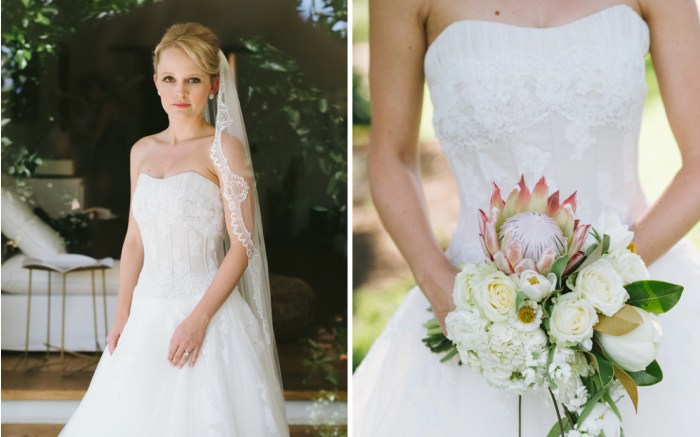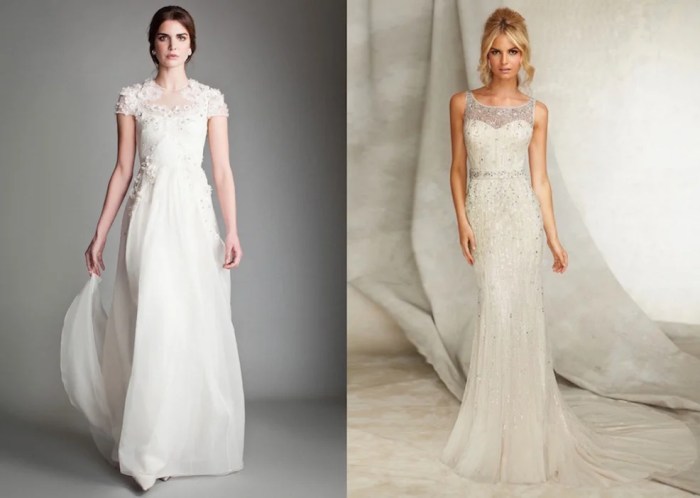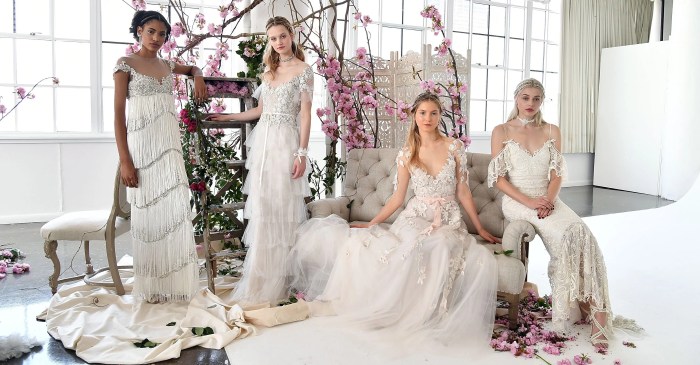Defining “Designer Wedding Reception Dresses”
Designer wedding reception dresses represent a significant investment, offering superior quality, craftsmanship, and unique design elements not typically found in standard gowns. The distinction lies in the meticulous attention to detail, the use of high-end fabrics, and the overall exclusivity of the design.
Characteristics of Designer Wedding Reception Dresses
Designer wedding reception dresses are characterized by their superior quality fabrics, intricate embellishments, and unique silhouettes. They often feature handcrafted details, such as hand-sewn beading or embroidery, that are absent in mass-produced gowns. The fit and construction are also superior, ensuring a flattering and comfortable silhouette.
Price Range Variations
The price range for designer wedding reception dresses varies significantly depending on the designer, the fabrics used, and the level of embellishment. Prices can range from several thousand dollars to tens of thousands of dollars for truly exclusive, bespoke creations. The price reflects the quality of materials, the labor involved in creation, and the designer’s reputation.
Key Design Elements
Common design elements in designer wedding reception dresses include intricate lacework, delicate beading, exquisite embroidery, and unique silhouettes. These dresses often feature luxurious fabrics like silk, satin, or tulle, and may incorporate modern or classic design elements depending on the designer’s aesthetic.
Popular Styles and Trends
Current trends in designer wedding reception dresses showcase a diverse range of styles, reflecting evolving fashion sensibilities. Silhouettes, necklines, and embellishments all play a significant role in defining the overall look.
Current Trends in Designer Wedding Reception Dresses
Current trends favor both classic elegance and modern minimalism. Popular silhouettes include A-line, mermaid, and sheath styles. Necklines range from classic sweetheart and V-necks to more modern halter and off-the-shoulder styles. Embellishments are diverse, with lace, beading, and subtle sparkle remaining popular choices.
Popular Fabrics Used in High-End Wedding Reception Dresses

Source: co.za
| Fabric | Texture | Common Uses | Pros/Cons |
|---|---|---|---|
| Silk | Smooth, luxurious | Entire gown, or as accents | Pros: Luxurious drape, breathable. Cons: Can be expensive, requires delicate care. |
| Satin | Smooth, lustrous | Bodice, skirt, or entire gown | Pros: Elegant sheen, drapes well. Cons: Can be unforgiving on body imperfections, prone to wrinkling. |
| Tulle | Delicate, sheer | Skirt overlays, veils | Pros: Creates volume, romantic look. Cons: Can be easily damaged, requires careful handling. |
| Lace | Intricate, delicate | Bodice, sleeves, skirt overlays | Pros: Adds texture and detail, romantic look. Cons: Can be itchy, requires careful cleaning. |
Comparison of Designer Wedding Reception Dress Styles
A-line dresses offer a flattering silhouette for various body types. Mermaid gowns emphasize curves, while ballgowns create a dramatic, princess-like look. Sheath dresses provide a sleek, modern aesthetic. The choice depends on personal preference and body shape.
Design Elements and Details
The artistry of designer wedding reception dresses lies in the careful selection and execution of design elements, creating a cohesive and stunning look.
Use of Embellishments
Lace adds delicate texture and romantic appeal. Beading provides shimmering accents, while embroidery offers intricate detailing. These embellishments are often strategically placed to enhance the dress’s silhouette and overall design.
Impact of Necklines
Sweetheart necklines create a romantic, feminine look. V-necks elongate the torso, while halter necklines offer a modern, sophisticated feel. The choice of neckline significantly influences the overall aesthetic of the dress.
Three Wedding Reception Dress Sketches
Design 1: A classic A-line gown in ivory silk, featuring delicate French lace appliqués on the bodice and a flowing skirt with subtle train. The neckline is a simple V-neck, emphasizing elegance.
Design 2: A modern mermaid gown in blush-colored satin, with intricate beading cascading down the skirt. The halter neckline adds a touch of sophistication, and the fitted silhouette accentuates the figure.
Design 3: A bohemian-inspired ballgown in ivory tulle, with embroidered floral details throughout. The off-the-shoulder neckline and flowing skirt create a whimsical, romantic look.
Brands and Designers
Numerous renowned designers specialize in crafting exquisite wedding reception dresses, each with their unique design philosophy and target market.
Examples of Renowned Designers
Vera Wang is known for her modern and often minimalist designs. Monique Lhuillier is celebrated for her romantic and luxurious gowns. Oscar de la Renta’s designs often feature intricate details and classic elegance.
Comparison of High-End Wedding Dress Brands

Source: feedinspiration.com
Vera Wang caters to a modern bride seeking sleek and sophisticated designs. Monique Lhuillier targets a bride who appreciates romantic and luxurious details. Oscar de la Renta appeals to a bride who values classic elegance and timeless style.
List of Designer Brands (Alphabetical Order)
- Carolina Herrera: Known for sophisticated, timeless elegance.
- Inbal Dror: Celebrated for dramatic silhouettes and intricate beadwork.
- Zuhair Murad: Famous for glamorous, heavily embellished gowns.
Fabric and Construction
The choice of fabric and the quality of construction are paramount in determining the overall quality and feel of a designer wedding reception dress.
Types of Fabrics and Their Properties
Silk is known for its luxurious drape and breathability. Satin offers a smooth, lustrous finish. Tulle provides volume and a romantic feel. Each fabric contributes unique qualities to the final garment.
Construction Techniques
Designer wedding reception dresses are meticulously constructed, often employing techniques like hand-sewing, French seams, and boning to ensure a perfect fit and lasting durability. The attention to detail is a hallmark of high-end craftsmanship.
Difference in Fabric Quality

Source: popsugar-assets.com
The difference between a high-quality silk and a lower-quality alternative is noticeable in the drape, luster, and overall feel. High-quality fabrics have a richer texture, drape more elegantly, and retain their shape better.
Accessorizing Designer Dresses
Accessories play a crucial role in completing the overall look of a designer wedding reception dress, enhancing its aesthetic appeal and reflecting personal style.
Accessories that Complement Designer Dresses
Jewelry, veils, shoes, and handbags are common accessories. The selection should complement the dress’s style and the overall wedding theme.
Impact of Accessories on Overall Look
A delicate veil can add a touch of romance, while statement jewelry can elevate the drama. Shoes can subtly alter the silhouette, and a clutch can add a finishing touch.
Color Coordination and Style
Color coordination is key to creating a harmonious look. Accessories should complement the dress’s color palette and overall aesthetic. The style of the accessories should also align with the dress’s design.
Finding and Purchasing Designer Dresses: Designer Wedding Reception Dresses
Acquiring a designer wedding reception dress requires careful planning and consideration of various factors.
Process of Finding and Purchasing
Start by setting a budget and researching designers whose styles resonate. Make appointments at bridal boutiques or explore reputable online retailers. Allow ample time for alterations.
Resources for Finding Designer Dresses
Bridal boutiques offer personalized service and a curated selection of gowns. Reputable online retailers provide a wider range of options, but require careful vetting.
Importance of Trying on Dresses and Fittings
Trying on dresses is crucial to assess fit, style, and comfort. Multiple fittings are often necessary to ensure the perfect fit and desired alterations are achieved.
Frequently Asked Questions
What is the average lifespan of a designer wedding reception dress?
With proper care and storage, a designer wedding reception dress can last for many years, even decades. The quality of the materials and construction contributes significantly to its longevity.
Can I alter a designer wedding reception dress?
Yes, many designer wedding dresses can be altered to achieve the perfect fit. However, it’s crucial to use a reputable alterations specialist experienced with working on high-end garments.
Designer wedding reception dresses offer a wide array of styles, from classic elegance to modern chic. For brides seeking a unique and dramatic look, a departure from traditional white might be considered, perhaps something like a stunning black witch wedding dress for a memorable change of pace. Ultimately, the ideal reception dress should reflect the bride’s personality and complement the overall wedding aesthetic.
How do I care for my designer wedding reception dress after the wedding?
Professional cleaning is recommended. Follow the care instructions provided by the designer. Proper storage in a breathable garment bag will help prevent damage.
Are designer wedding reception dresses worth the investment?
The value of a designer dress depends on individual priorities. Consider the quality of materials, craftsmanship, and the lasting memories associated with wearing a unique and beautiful garment.
